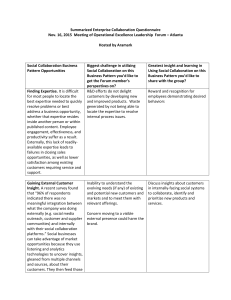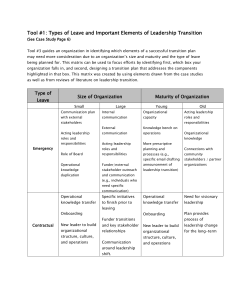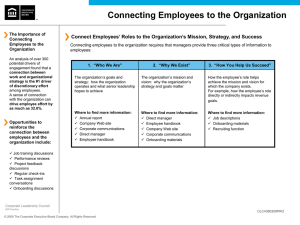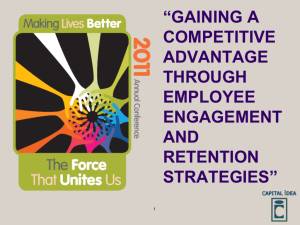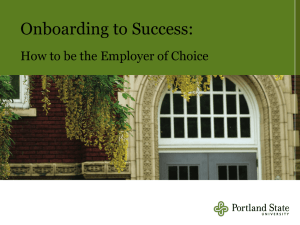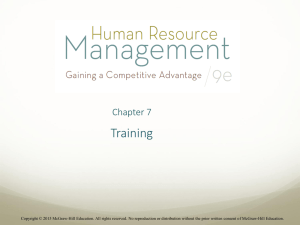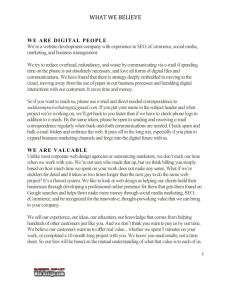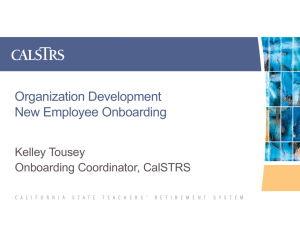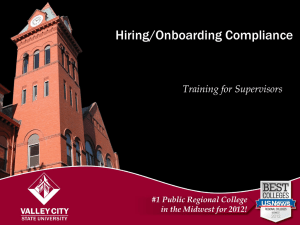*If you put the bright lights to it, it will get done
advertisement
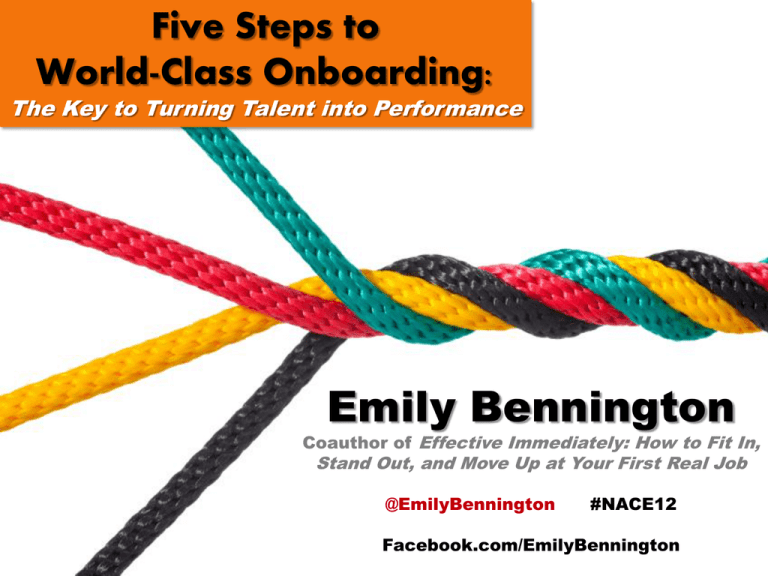
Five Steps to World-Class Onboarding: The Key to Turning Talent into Performance Emily Bennington Coauthor of Effective Immediately: How to Fit In, Stand Out, and Move Up at Your First Real Job @EmilyBennington #NACE12 Facebook.com/EmilyBennington My first jobs. Q: According to Monster.com – what percentage of external hires are no longer with their organization after two years? I QUIT! A: 30 Q: According to the Bureau of Labor Statistics, two generations ago, the average person held SIX jobs in their lifetime. What is the average today? A: 11+ Q: According to the Bureau of Labor Statistics, what percentage of a person’s salary does it cost to replace them? A: 25% Source: Monster.com survey of 3,700 job seekers and 1,250 hiring managers. When you spend a *%&^$ recruiting people, it sucks when they leave. Every business must understand the shocking amount of turnover today isn’t about entitled new hires. It’s about disengaged new hires. THIS IS NOT ONBOARDING! Neither is this. Onboarding Rule #1 Live Up to Recruiting Cycle Promises Gen Y isn’t disloyal. They just want meaning. Don’t think your mission and value statements are enough. Which company had these four “values” chiseled in marble in the main lobby of their HQ? Integrity Communication Respect Excellence Introducing the shock absorber. Also known as... YOU. Shock Absorber #1: Don’t take a sales approach to your culture. Shock Absorber #2 Help newbies manage through key “firsts” First administrative problem. First on-the-job mistake. First personality conflict. First real “win.” First time receiving negative feedback / constructive criticism. First public recognition (or failure to be recognized). First time new hire doesn’t know the answer. First company-sponsored social event. First time speaking up at a meeting. First presentation at a meeting. First client visit. Onboarding Rule #2 Commit to Six Months (at least). What’s the first thing that comes to mind when I say orientation? This? For most new hires, it’s this! When Do New Employees “Break Even?” Contribution Breakeven point = Net contribution zero 1 2 Months After Entry Source: Michael Watkins, Your First 90 Days 3 4 5 6 7 Timeframe an Employee Makes a Decision to Stay The first day The first week The first month The first six months The first year The first two years The first five years Other 0% 5% 10% 15% 20% 25% 30% 35% Focus on Bite-Sized Learning in Three Areas Technical Cultural Social Host one training / event in each section every quarter. Survey through every step. 1 month 6 month One Year Sample Questions: Do you feel the company is meeting your expectations? Are you experiencing any difficulties with our technology? Do you feel like you have the tools and resources you need? Have you outlined strategic goals with your supervisors? Do you feel you’re making progress on those goals? NOTE: Someone needs to be held accountable for this! Onboarding Rule #3 Set Written, Measurable Goals. Success Story: Bank of America New hires identify important successes to aim for during the first 90 days. Success Story: Larson & Rosenberger, LLP Each year, employees sign an “Expectations Agreement” with four parts: 1.) Employee establishes professional goals within the firm. 2.) Employee states personal goals. 3.) Employee states how firm can help them achieve both. 4.) The firm’s expectations of the employee are outlined. L&R is a medium-sized accounting firm with 60 employees. Employees receive quarterly bonuses based on the achievements made toward their agreements. Keeping your keepers. (Hint: It’s not all about the money.) In a study of more than 584 employed Americans, how many hadn’t established any career goals in collaboration with their manager? 82% Source: Kelton Research / Cornerstone OnDemand Employee Attitude Survey, 2009 Written goals matter because… Many complaints about underperformance really stem from two things: Poor communication Unclear expectations Without written performance standards, employees measure themselves against: Each other Really wants to be in marketing New dad Seeks extra feedback Pottery lover Travel buff Looking for a mentor Hanson fan Onboarding Rule #4 Manage to the Individual. Get ‘em Talking! Don’t forget that younger employees most likely have questions about career and work norms that older hires may take for granted. Ask people from the start how they prefer to be managed. Explain what success looks like so your employees won’t waste time on things that don’t matter. Give Feedback In the same study of more than 584 employed Americans, how many hadn’t received any kind of useful feedback from supervisors in the last six months? 58% Source: Kelton Research / Cornerstone OnDemand Employee Attitude Survey, 2009 Onboarding Rule #5 Purposefully Enhance Your Brand. Culture eats strategy for breakfast. Four Promises You Should Make Every New Hire 1.) You will work to develop them as people in alignment with company goals. 2.) You will give them the resources they need to do their job effectively. 3.) You will provide them with transparent and frequent communication. 4.) You will hold them accountable for clearly-defined performance standards. What does this have to do with your brand? “How’s the new job going?” “Sales” Funnel 1.0 “Sales” Funnel 2.0 Thanks to social media, your current clients / new hires are finding your future client / hires. You can get all of this right but… …you’ll still lose people if you don’t have what? Great managers. 2005 2011 “The only thing worse than training employees and losing them, is NOT training and keeping them.” Zig Ziglar Questions. #1: Why do onboarding programs fail? No one is directly responsible. Viewed as a checklist or “orientation paperwork.” Limited management interest or involvement. Material introduced is never reinforced later. What’s the fastest way to get the attention of company leadership? Proper onboarding has been proven to improve retention rates by how many percentage points? 2-6% #2. What if your onboarding is global? Cisco’s Onboarding program is called “Fast Start” and each new hire receives a peer sponsor (or “buddy”) as well as access to this online network of familiar faces. http://www.cisco.com/E-Learning/prod/curriculum/newhire/www/index.html #3. What are some best practices for pre-start and/or day one engagement? Pre-Start 1. Send care package. 2. Complete paperwork in advance. 3. Phone call from supervisor. 4. Fun welcome video from staff. Day One 1. Receptionist / staff greeting. 2. Block off most / all of the day. 3. Have office supplies / cards ready. 4. Schedule lunch with colleagues. 5. Give them an engaging task / goals to meet by the end of the week. #4. How do you measure success? 1. Retention 2. Survey Responses 3. Morale / Performance 4. Online / HR engagement #5. How do you deal with unrealistic expectations? 1. Be very clear about promotion channels / path. 2. “Prove you’re worth it.” #6. How do you lose engagement? 1. Micromanagement 2. Ambiguity 3. Chaos #7. How do you keep engagement? Mastery Autonomy Purpose EmilyBennington.com/nace Emily Bennington Facebook.com/EmilyBennington @EmilyBennington emily@emilybennington.com
